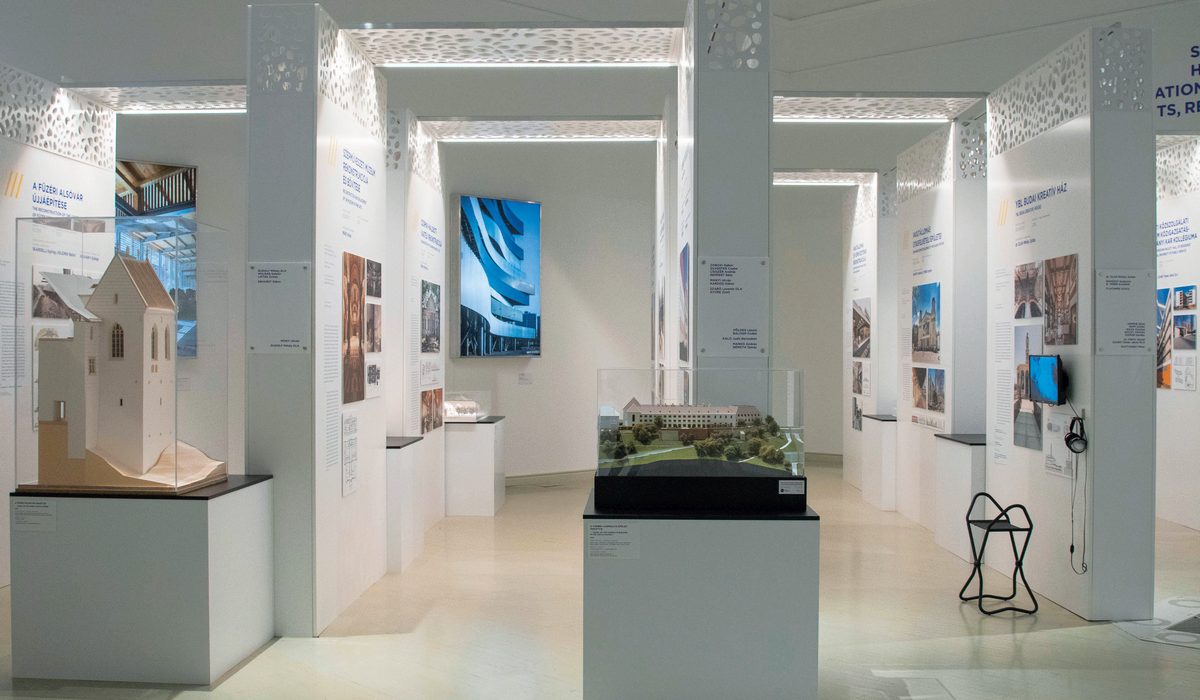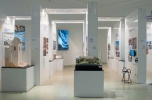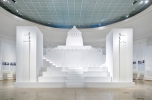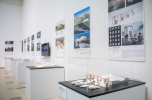COVER /// AGE – 2nd National Salon of Architecture
Kunsthalle, Budapest, 26 April – 25 August 2019
Photos: Műcsarnok, Béla Ilovszky / theater.hu
In the last five years the Műcsarnok has served as the venue for the National Salons, which have attracted significant interest from professional circles and the lay audience alike. Every year the fresh achievements of another genre are presented. In 2019 architecture is in focus, with special emphasis on communal force and collective activity, which play an increasing role in architectural space and its creation.
Community building and solidarity in architecture will be a separate thematic unit, and a whole section will be devoted to the activity of the architects of the now legendary Miskolc Architectural Workshop (1977–1990) from the formation of the group to the present day. The exhibition chapter in the Műcsarnok’s apse pays tribute to István Medgyaszay (1877-1959), one of the most important and innovative figures of 20th-century Hungarian architecture. The unit titled “The Silhouettes of the Future” focuses on the life and architectural space of coming generations. An interactive installation by Hello Wood inviting visitors to engage in architectural thinking and “Light Architecture”, aimed at creating the experience of space with immaterial light, can both be seen in one of the side halls.
Cross Section 2014–2019
curator: György Szegő DLA architect, applied artist and the arts director of the Műcsarnok
The three halls in the middle of the exhibition space present an architectural cross-section of half a decade through displaying projects that were completed in the past five years and some key investments that are under construction. The more than 120 projects in this section are bound together by high architectural quality and are arranged into three thematic units: residential and sacred buildings with communal functions; monument reconstructions and extensions; and functions linked to culture, science, sports and hospitality-tourism.
Community and Architecture
curator: Mihály Balázs architect, full professor of the BME, member of the Hungarian Academy of Arts
The exhibition highlights three aspects of the complex relationship between the community and architecture. These are: the new opportunities of architecture and education; the nature of architecture as a shaper of creative communities; and the socially engaged architecture that recognises and sets out to alleviate disadvantage. A common feature of these three categories is that they go beyond the classic aesthetic interpretation of architecture and react to the spectacular but not always welcome social and environmental changes under way today. Humankind is now faced with various phenomena that are difficult to manage, even in isolation. These include population growth, climate change and the latest wave of the scientific and tech revolution. The combined impact of these, however, is throwing up challenges of a kind that have never been experienced before. Architecture, as an activity that shapes the social and natural environment, is partly responsible for generating these tensions; but it also has the tools with which to alleviate them. This exhibition focuses on the latter.
The Miskolc Architectural Workshop
curator: Miklós Sulyok art historian, member of the Hungarian Academy of Arts
The Miskolc Architectural Workshop grew from a circle of friends studying architecture who were already seeking opportunities in the years before graduation to settle and work together, and eventually they found a welcoming place in the seat of Borsod County.
The city of Miskolc welcomed the group, what is more, they allowed them to design their future shared residence: this has become the well-known Collective House, one of the best-known works of its architect Csaba Bodonyi, as well as a leading example of the experimental use of a prefabricated building system in Hungary.
The architectural interests of the Workshop spanned the full spectrum of design from whole cities to individual objects. In the midst of the crisis in modern architecture and urban development, their attention turned to an examination of historical urban settlements.
The Silhouette of the Future
curator: Bálint Botzheim architect
Society is shaped by the changes in technology. The young generation creates the link between the present and the future. The exhibited degree projects and – mainly conceptual – proposals made for international design competitions provide examples for ways of thinking that go beyond stereotypes.
Technological singularity is symbolised by a 3D printer which will clone the spaces of the Műcsarnok during the entire period of the exhibition – for now only at the scale of mock-ups. Another burden for modern civilisation is the growth-driven global economic model, conveying the implicit message: what you have is not good enough, not environmentally friendly enough, so replace it with something new. The waste-barge displayed at the exhibition symbolises environmental pollution.
Medgyaszay István the Modern
curator: Ferenc Potzner DLA
To mark this anniversary, the National Salon of Architecture includes a commemorative exhibition evoking his career and philosophy, showing the endeavours that make Medgyaszay almost contemporary even now, in the early 21st century. He pursued his creative activity, commenced at the turn of the 19th and 20th centuries, uninterrupted for half a century without being forced to make any major diversions. What makes his oeuvre so consistent is that his architecture was based on universal principles that recognised and respected the natural laws of the materials and structure. This was paired with tradition which, combined with modern technologies, created his unique, individual style.
Builders’ Room | Hello Wood installation
curator: Péter Pozsár architect
26 April – 22 June, 2019
The Hello Wood Studio’s installation attempts to make architecture more visible and bring it closer to the person on the street. The installation aims to encourage visitors to take part in manual, physical activity, and give them an opportunity to interact by expressing their general opinions in the form of data elicited in response to Hungarian architecture. The symbolic architectural machinery constructed in the hall is essentially a playground that gives visitors hands-on experience of the stages in a linear process, enabling them to deepen their thinking about architecture, while relying on them as collaborators in the creation of an outdoor installation that is the end product of the process.
Light Architecture
curators: Sándor Böröcz lighting expert, Bálint Botzheim architect
5 July – 25 August, 2019
The installation visualises the conception of architectural form abstractly, in a special light matrix. Thanks to the semi-virtual display, the movement of space can be perceived and the successive metamorphoses of the spaces can also be understood: visitors can experience symbolically and physically the sensations aroused by spaces created with the different three-dimensional construction methods and thus can witness the process of architectural invention. Animation is present in the entire realm of contemporary architectural creation from architectural geometry that closely follows natural forms through abstracted forms all the way to new geometrical forms in virtual space.
Architectural design competitions 2014–2019
The panorama provided by the 2nd National Salon of Architecture can only be complete if the constructed buildings, squares and other architectural results are complemented with a survey of the most important architectural design competitions in Hungary in the given period as well as those international competitions where the designs of Hungarian architects achieved significant success. These competitions exert an important influence on the architectural scene, and the implementation of the submitted plans in the future and the ideas summed up in them can inspire and shape the oeuvres and attitudes of other architects.
Tree of Hungarian architects
A spectacular visual element at the 1st National Salon of Architecture (2014) was the Tree of Hungarian Architects, which paid tribute to 120 prominent architects of Hungarian architectural history spanning from 1750 to 1950. The memorial column contained the name of each architect and a highlighted work by him or her. This installation can be seen at this year’s National Salon of Architecture too but extended with the names and a work each by Hungarian architects who passed away between 1950 and 2014, and exerted a major impact on 20th-century Hungarian architecture, not least upon the generation of architects active today.
Post Mortem
This is the first National Salon at the Műcsarnok with a section paying tribute to architects who passed away in the five years that passed since the last National Salon exhibition. The architects briefly evoked had not so long ago still played an active part in shaping Hungarian architectural culture, and they are sadly missed in the day-to-day reality of the profession. Besides them, architectural writers, editors of periodicals, film directors and teachers whose oeuvres enriched contemporary Hungarian architecture are also commemorated.



